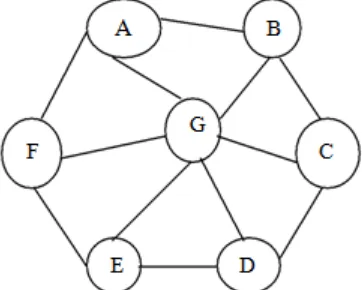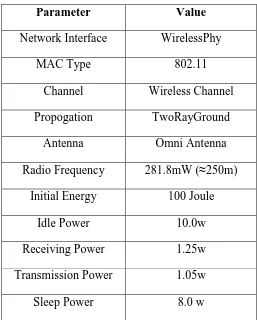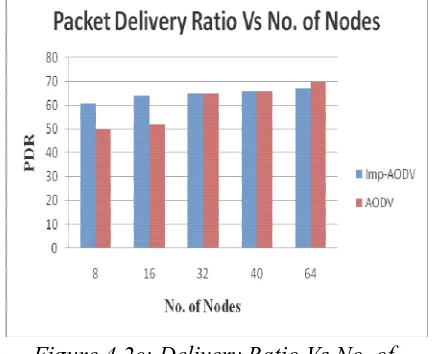Implementation and Performance Evaluation of Energy Constraint AODV Routing
-
Ram Mani Rai, Mr. Mahesh Kumar Page 368Implementation and Performance Evaluation of
Energy Constraint AODV Routing
Ram Mani Rai1
,
Mr. Mahesh Kumar2Department of Computer Science and Engineering Monad University, Hapur, India
rai.rammani@gmail.com, maheshkumar908@gmail.com
Abstract:
The aim of this paper is to evaluate the performance of an energy aware routing protocol, called E-AODV (Energy Constraint on AODV) which derives from the AODV protocol and which is based on the local decisions of intermediate stations to maintain the connectivity of the network as long as possible. The results obtained using the Network Simulator NS-2 demonstrates how small changes in the principle of the AODV protocol can efficiently balance the energy consumption between nodes, which increases the network lifetime. The performance parameters are energy consumption and Packet delivery ratio. The simulation result of new protocol is compared with AODV protocol and it is obtained using Network Simulator NS-2 (Version 2.34) [13].The performance parameters are energy consumption and delivery ratio. The simulation result shows that energy consumption is reduced up to 25%-30% with CBR traffic and it is slightly affect the Delivery Ratio.
Implementation and Performance Evaluation of Energy Constraint AODV Routing
-
Ram Mani Rai, Mr. Mahesh Kumar Page 3691. INTRODUCTION
A mobile ad hoc network is a collection of autonomous mobile nodes that communicate with each other in the absence of any fixed infrastructure. In this type of network, each node is likely to take part in the routing process and to retransmit the packages of a node which is not able to reach its destination.
Indeed, when a destination node is out of reach of the source node, the connectivity between the two stations is maintained by the intermediate stations, which means that every node belonging to the chosen route must stay in active mode until the communication is concluded. Therefore, the energy constraint is a critical
issue for such a network, and a lot of works have focused on how to optimize the energy consumption and keep the same level of network efficiency. These works was principally interested on the routing layer, and tried to propose optimized routing protocols that take into consideration the energy constraint.
In fact, routing in these networks is based on a simple and intuitive approach: the retransmission of the packets by each node allows the propagation through the network. The problem lies in the choice of the optimal route. The totality of routing protocols, suggested by the Mobile Ad-hoc Network group (MANET) of the Internet Engineering Task Force (IETF), use the same routing metric which is the shortest path. In other words, the paths are computed based on the minimization of the number of intermediate nodes between the source and the destination. Thus, some nodes become responsible for outing packets from many source destination pairs. After a sort period of time, the energy resources of those nodes get depleted, which leads to node failure. It is therefore significant that the routing protocols designed for ad hoc networks take into account this problem. Indeed, a better choice of routes is one where packets get routed through paths that may be longer but that contain only nodes that
have enough energy. This paper aims at specifying an energy aware routing protocol based on this concept, and derives from the most known routing protocol: AODV (Ad-hoc On demand Distance Vector). We show that this improve of AODV, called Imp-AODV (Local Energy Constraint Based AODV), increases the network lifetime by simply using energy aware routing metric. This protocol is in fact a simplification of the optimized protocol LEAR-AODV, developed by M.Senouci in [8]. The next section of this paper provides a brief description of the AODV routing protocol developed by the IETF. Section 3 draws attention to the energy conserving routing protocol, Imp-AODV that we have implemented. Simulation results obtained using the Network Simulator NS-2, are presented in section 4. Finally, section 5 summarizes the main results and outlines our future research.
AODV ROUTING PROTOCOL
AODV (Ref [3] [12].) is based on two principal processes: route discovery and route maintenance. When a node wants to establish a communication with another one without predefining the route, it starts the procedure of route discovery: the source broadcasts to its neighbors’ a packet called RREQ (Route
Request). This packet will register the list of
nodes visited during the propagation through the network. Any intermediate node which receives this request for the first time broadcasts it in its turn to its neighbors’, until the packet arrives to the destination node. This one answers by a packet called RREP (Route Reply) in recursive diffusion towards the source, and in this way, the shortest route is found between the two nodes. The route maintenance procedure is needed during the communication time because of topology changes.
Implementation and Performance Evaluation of Energy Constraint AODV Routing
-
Ram Mani Rai, Mr. Mahesh Kumar Page 370be destroyed in the routing tables of the intermediate nodes. With AODV, each node in the network maintains the list of its immediate neighbors, by periodic exchange of small sized packets, called HELLO messages.
2.1. THE ENERGY MODEL USED IN NS-2
The NS-2 extension includes an energy model that informs any node about its instantaneous energy level. To use his model, we must define three parameters: the initial energy (InitialEnergy), the transmission power (txPower) and reception power (rxPower). These two last values, Multiplied by the duration of transmission or reception of a packet, give respectively the quantity of energy necessary for the transmission or the reception of a packet. In our simulation study, we have fixed these parameters to the following values:
rxPower =1.25 (Watt) txPower =1.05 (Watt) initialEnergy = 100 (Joule)
We have assigned to each node an initial energy of 100 joules which will be decreased as the node transmits or receives packets. If the energy level of a node reaches zero, it is seen as a ‘dead’ node, i.e. it is no longer able to take part in communications.
It is known that the energy consumption of a node is mainly due to the transmission and the reception of data or controlling packets (such as RREQ, RREP, RERR, HELLO). To measure this amount of energy consumed during the transmission process (noted txEnergy), we should multiply the transmission power (txPower) by the time needed to transmit a packet:
txEnergy = txPower x (packetsize/bandwidth)
And for a received packet:
rxEnergy = rxPower x (packetsize/bandwidth)
2.2. E-AODV: ENERGY-CONSRAINT on AODV
Implementation and Performance Evaluation of Energy Constraint AODV Routing
-
Ram Mani Rai, Mr. Mahesh Kumar Page 371Figure 1: An example ad hoc topology. Node G will participate in all communications between
A-D, B-E and C-F.
A. Route Discovery
When a source node wants to reach a destination node, it starts the route discovery process and broadcasts the route request packets (RREQ), as in AODV. But when an intermediate node receives this request, there is an additional step that it has to do before sending the packet: it must compare its remaining energy with a certain threshold. If it finds that its energy level exceeds the threshold value, it rebroadcasts the request to all its neighbors. In the other case, the node concludes that its remaining energy is not enough anymore to route the others’ packets. Therefore, the node rejects the RREQ packets and ignores the request.
As soon as the destination receives the first RREQ packet, it transmits a RREP towards the source. The treatment of these RREP packets by the source is identical to that of AODV. The example of figure 2 shows the difference between the route established by AODV and the modified AODV. In this network, we can note that with the modified AODV, the route chosen between the end nodes S and D is longer than that built with the original AODV. In fact, with AODV, node 2 must participate in the communication despite its weak battery. The new modifications allow this node to remain alive for a longer time.
B. Route Maintenance
The maintenance of the route becomes necessary when the energy resources of certain nodes on the road become lower than the fixed threshold. During a communication, each intermediate node supervises the decrease of its energy level. Once the remaining energy reaches the threshold, the node must send a RRER packet to the source in order to launch a new route discovery process. In the same way, the maintenance of the road is made when the connections between two or several nodes on the route are lost because of their movements. In this case, the protocol proceeds just as in AODV: a new RRER packet is returned, and the route is removed from the routing tables.
Figure 2.a: Route established with AODV.
Implementation and Performance Evaluation of Energy Constraint AODV Routing
-
Ram Mani Rai, Mr. Mahesh Kumar Page 372These modifications lead to a new optimized routing protocol that was called imp-AODV (Local Energy Aware Routing based on AODV) [11] [14], by M.Senouci in [8]. It allows a node whose battery is used too much to refuse to route the traffic of the other nodes. The route built between any pair of nodes consists only of nodes whose energy level is higher than the threshold.
In what follows, we will analyze the results of the implementation of this optimized protocol under NS-2 environment.
SIMULATION ENVIRONMENT
The simulation of imp-AODV and AODV is done using NS-2 simulator version 2.34 [13].
3.1 Simulation Model: The wireless network consists of 20 numbers of nodes which are distributed randomly in a grid area of 1000m X 1000m with 10 numbers of connections. The initial energy of each node is taken as 100 J with transmission and receiving power consumption is 1.25W and 1.05W respectively. The data packet size is of 512 bytes. The simulation time is 600sec. The simulation model [8] with parameters is listed in table 1.
3.2 Traffic Model: The traffic model used is CBR (Constant Bit Rate). CBR Model generates traffic at a constant rate of 64packets/second.
Table 1: Simulation Parameters
Parameters
Value
Simulator NS-2 (Version ns-2.34)
Grid Area 1000 x 1000 m
Transmission
Range 200 m
Pause 0, 50, 100, 200, 300, 400
Mobility 1, 8,16, 24, 32, 40 m/s
Sending Rate 32 kbps
Packet Type CBR
Packet Size 512 Bytes
Number of Nodes 8, 16, 32, 40, 64
Simulation Time 720 sec
Table 2: Parameter for Energy Model
Parameter Value
Network Interface WirelessPhy
MAC Type 802.11
Channel Wireless Channel
Propogation TwoRayGround
Antenna Omni Antenna
Radio Frequency 281.8mW (≈250m)
Initial Energy 100 Joule
Idle Power 10.0w
Receiving Power 1.25w
Transmission Power 1.05w
Sleep Power 8.0 w
RESULTS
Implementation and Performance Evaluation of Energy Constraint AODV Routing
-
Ram Mani Rai, Mr. Mahesh Kumar Page 373 4.1 Energy ConsumptionFigure 4.1a: Energy Consumption Vs Pause Time
Figure 4.1b: Energy Consumption Vs Speed
Figure 4.1c: Energy Consumption Vs No. of Nodes
Figure 4.1a, 4.1b, and 4.1c shows the total energy consumed (Joules) due to control packets by varying pause time, speed and number of Nodes respectively.
4.2 Packet Delivery Ratio
Figure 4.2a: Delivery Ratio Vs Pause Time
Implementation and Performance Evaluation of Energy Constraint AODV Routing
-
Ram Mani Rai, Mr. Mahesh Kumar Page 374Figure 4.2c: Delivery Ratio Vs No. of Nodes
Here we also examined that if the metrics is based on energy what is the effect on the delivery ratio. Figure 4.2a, 4.2b and 4.2c shows the delivery ratio again varying the same parameters. The delivery
ratio for both the protocols shows similar behavior with CBR traffic models.
The above simulation results show the advantages of Imp-AODV over AODV protocol.
CONCLUSION
Here we conclude that Imp-AODV is better than AODV with CBR traffic model because:
1. There is 25% to 30% reduction in energy Consumption with CBR traffic.
2. There are slightly affect in the Delivery Ratio for both the Protocols.
REFERENCES
[1] B. Cameron Lesiuk, “Routing in Ad Hoc Networks of Mobile Hosts”, Department of technical Engineering, University of Victoria, Victoria, BC, Canada, December 2, 1998.
[2]Charles E. Perkins and Elizabeth M. Royer, “Ad hoc On-Demand Distance Vector Routing”, Proceedings of the 2nd IEEE Workshopon Mobile Computing Systems and Applications, New Orleans, LA, February 1999.
[3]Elizabeth M. Royer and Charles E. Perkins, “An Implementation Study of the AODV Routing Protocol”, Proceedings of the IEEE Wireless Communications and Networking Conference, Chicago, IL, September 2000.
[4] John A. Stine and Gustavo de Veciana, “A Comprehensive Energy Conservation Solution for Mobile Ad
Hoc Networks”, Department of Electrical & Computer Engineering, The University of Texas, 2002.
[5]Chansu YuBen Lee Hee Yong Youn, “Energy Efficient Routing Protocols for Mobile Ad Hoc
Networks”, Department of ECE. Cleveland State University, 2003.
[6]Ya Xu, John Heidemann, and Deborah Estrin, “Adaptive Energy-Conserving Routing for Multihop
Ad-hoc Networks”, USC-ISI Research Report 527, October 12, 2000.
Implementation and Performance Evaluation of Energy Constraint AODV Routing
-
Ram Mani Rai, Mr. Mahesh Kumar Page 375held devices”, IEICE Transactions on Communications, Special Issue on Mobile Computing, Invited paper,
E80-B(8): pp1125-1131, August 1997.
[8]M. Sidi-Mohammed Senouci, « Applications de Techniques d’Apprentissage dans les Réseaux Mobiles », doctorate thesis, Université de Pierre et Marie Curie, octobre 2003.
[9] Dhiraj Nitnaware, Pravin Karma and Ajay Verma, “Energy Constraint Gossip based Routing Protocol for MANET”, under review process.
[10] Zygmunt J.Haas, Senior member, IEEE, Joseph Y.Halpern, Senior member, IEEE, “ Gossip Based Ad Hoc Routing”, IEEE Transactions on networking, Vol.14, No.3, June 2006.
[11] M. Frikha and F. Ghandour, “Implementation and Performance Evaluation of an Energy Constraint Routing Protocol for MANET”, 3rd
International Conference of Telecommunications (AICT’07), IEEE,2007.
[12] Charles E. Perkins, Elizabeth M. Royer and S. Das, “Ad-Hoc On Demand Distance Vector Routing (AODV)”, draft-ietfmanet-aodv-05.txt, March 2000.
[13] Network Simulator, ns-2,
http://www.isi.edu/nsnam/-ns/.


